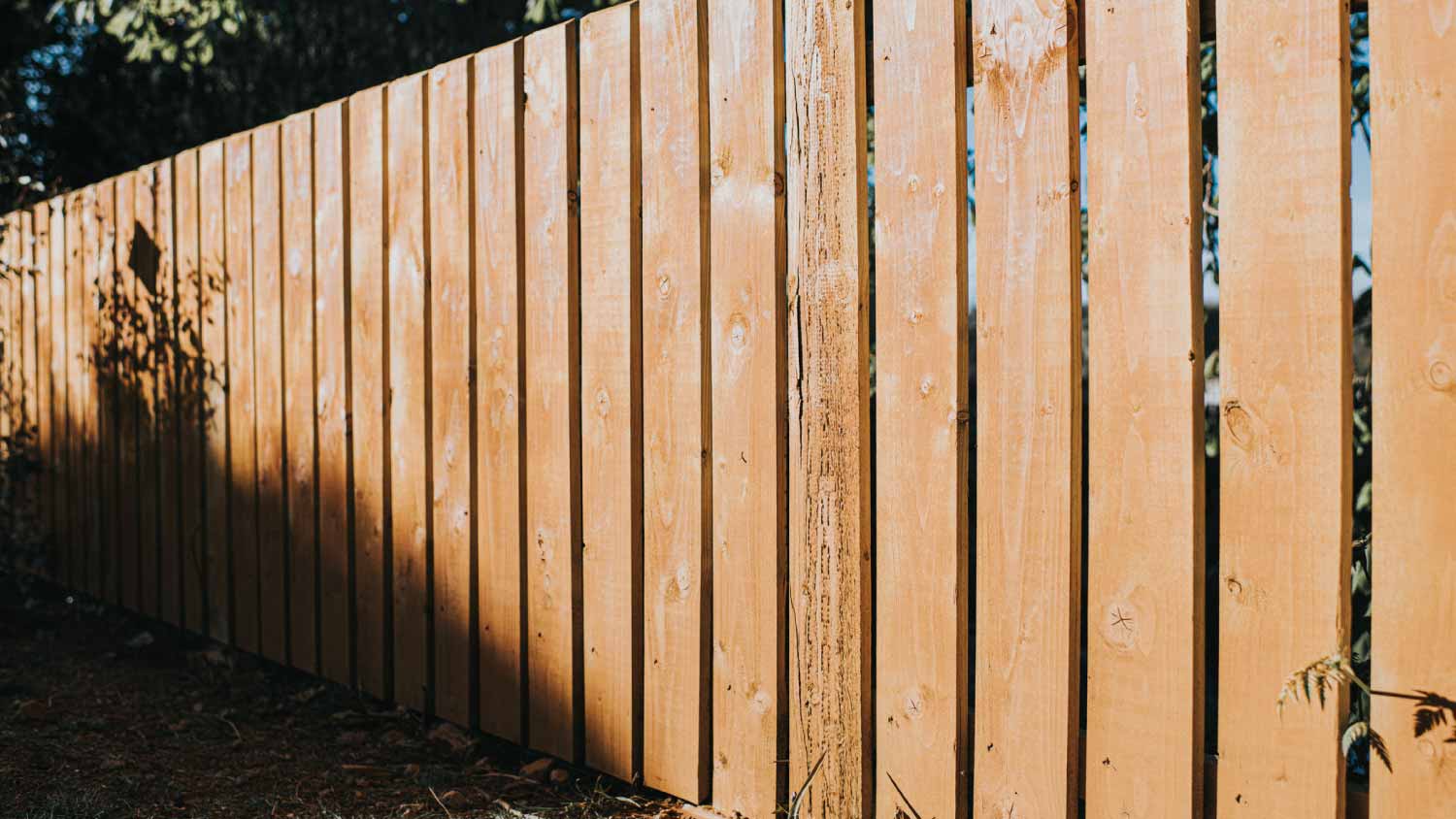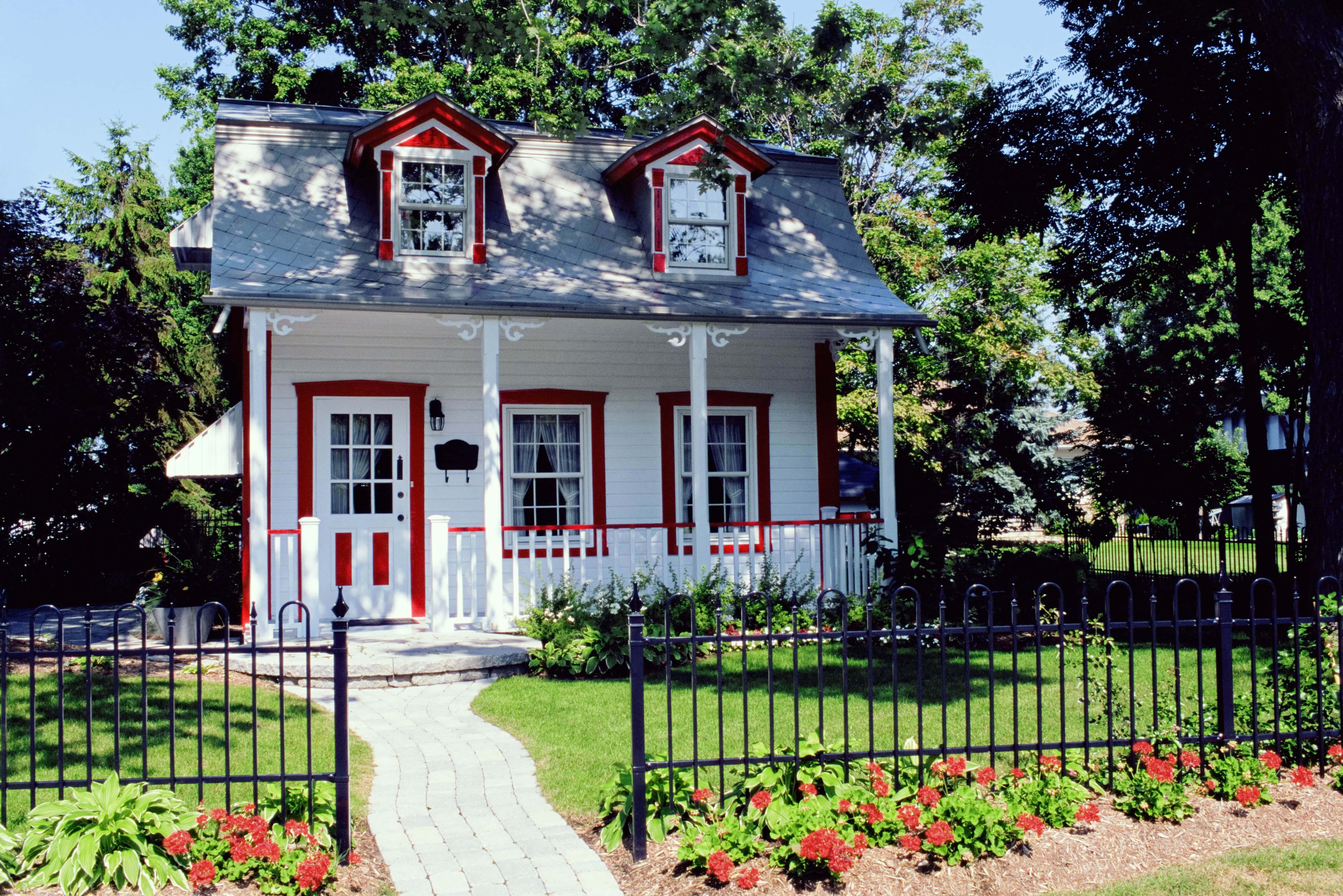16 Excellent Privacy Fence Ideas for Your Outdoor Space
Don’t let a lack of privacy have you feeling “on the fence” about your backyard


Privacy fences let you gather with your friends comfortably without worrying about the gaze of neighbors, passersby, or cars on the road. But building a fence can be a big project, whether you choose to DIY or hire a professional. You’ll need to check your local zoning laws for height restrictions, verify property lines, and may need to get your construction plans approved in advance.
Once you’ve got the stressful prep work out of the way, it’s time to get inspired. Check out these privacy fence ideas, from unique, budget-friendly materials to traditional styles we all know and love.
Check your local regulations before building a tall fence. Most cities will allow you to build a 6-foot fence, but special permits may be required for fences over 7 feet.
1. A Solid-Backed Chain-Link Fence

While a chain-link fence is budget-friendly, it’s not ideal on its own in terms of privacy. However, it gets the job done if you’re looking to keep your children safe and protect your pets from wild animals.
Get more privacy out of your chain-link fence by tautly securing mesh, tarp, or canvas material along one side of the fence.
Another option is to plant a line of trees or shrubbery along the fence. Faux boxwood greenery is another great option here, too.
2. Pallet Fence

Wood pallets are usually easily accessible and often free for those willing to pick them up and carry them out themselves. A truck or SUV would be necessary here.
Though a pallet fence is budget-friendly, it requires a bit of DIY handy work. The plus side is that you can get as creative with it as you’d like. Try weaving LED lights through the panels or installing a garden with hanging planters as pictured above.
3. Faux Boxwood Greenery Fence

Boxwood greenery is very trendy and works great as a privacy wall, especially as a DIY project. You can get faux boxwood greenery in several different forms, including square panels and hedge rolls. This option works best on existing fences that might be a little too see-through, such as a chain-link fence. Simply use zip ties to secure the greenery to the fence tightly. You can add greenery around the entire fence or just in areas where you would like more privacy.
4. Horizontal Wood Fence

Wood fences are always a great option because while they give any space a classic look, they’re also easy to DIY if you’re handy with wood and a set of tools. Opt for a fence with horizontal wood planks, like a louver fence, to achieve a modern look that allows you to peek outside without letting others peek in.
5. Vertical Wood Fence

Since wood fences are so customizable, you can line up vertical slats that are taller than the average fence to create the effect of walls outdoors. Vertical board fences feature close-together slats for more security, but a picket fence will do if you don’t mind some space between slats.
6. Tree Line Fence

Not only does a tree line fence help for privacy, but it can also provide a bit of shade in your backyard—perfect for lounging outside in the summer.
You can plant the trees yourself, or hire a local landscaping company to do it for you.
7. Shrubbery or Hedge Fence

Add a shrubbery or hedge fence for seclusion by planting them on your own or hiring a professional landscaper to help.
Shrubs and hedges can create a fence line on their own, or they can be installed alongside an existing fence that could use a little more privacy.
Keep in mind that this option does require regular trimming and maintenance.
8. Bamboo Fence

Bamboo fencing is a great natural fence option, especially if you’re hoping to create a relaxing, tropical atmosphere in your backyard.
9. Picket Fence

A picket fence is one of the most classic and well-known types of fencing. For maximum privacy, opt for a tall picket fence or plant trees or shrubbery along the perimeter. Material options for picket fencing include natural wood, vinyl, cellular PVC, composites, and even metal.
10. Vinyl Fence

Vinyl fencing is a great option. Not only does it provide safety and seclusion, but it also needs less long-term maintenance when compared to a wood fence. Plus, a vinyl fence takes less time to install than wood—which means lower labor costs.
Vinyl fencing also looks very clean-cut and cohesive, giving your home a more luxurious appearance.
11. Panel Fence

A panel fence is a type of fence that is built in multiple framed sections. This option provides a lot of room for customization in way of design and materials. Go for a natural all-wood look, or add textured metal sheets between the frames for a more industrial feel.
12. Earthy Stone Fencing

A stone fence is a great way to add privacy to your home. It has a natural feel that’s as common in a suburban residential neighborhood as it is in European highland regions, like in the UK. You can create a wall of stone by stacking and securing it with mortar—also known as a mortar stone wall.
13. Unexpected Gabion Fencing

Gabion fencing is a style of stone fencing where, instead of mortar, stones are stacked up in a metal basket that borders a garden or space. Compared with other professionally installed fences, these fences are cost-effective, but as a DIY project, they can be hard to pull off without help from a local fence installer.
14. Trellis Fencing

Trellis fencing is a diamond-patterned panel, typically made of wood or vinyl. Stack vinyl trellis panels side-by-side to build a whimsical privacy fence, or add wood trellis to the top of your current fence for extra height and coverage. The cost to install a trellis is about $400 to $2,400.
15. Iron Fence

Though a classic iron fence is beautiful, it doesn’t usually provide enough coverage for privacy. If your heart is set on an iron fence, consider also investing in trees or shrubbery to go along the perimeter of your fence where you’d like a little extra privacy.
16. Brick Wall Fence

A brick wall can be built as low or as high as you’d like—or your city or town allows. For lower brick walls, we suggest adding trees, boxwood, or tall shrubbery along the fence line for more seclusion. If landscaping isn’t in your budget, a more affordable way to get more coverage is to add trellis panels along the top instead.
Caroline Gilbert contributed to this article.
Frequently Asked Questions
Of all the fencing options, the cheapest type is a repurposed pallet fence because it’s made of used materials that are easy to find for free. But if you’re not interested in the DIY game, customize a covered chain link fence or a plain wood fence to provide the best privacy possible.
When it comes to maintenance, vinyl fencing is your best bet for not having to worry about scratches, repainting, or wear and tear from the weather. Vinyl is a material made of polyvinyl chloride (also known as PVC) that can last for years without requiring repairs or maintenance. It’s also one of the lower-cost fence materials to build with.
Planting greenery on a fence can help achieve more privacy, whether it’s shrubs along a picket or chain link fence or rolls of faux greenery to help create a solid-colored backdrop beyond the fence line. You can also try adding more lattice or paneling across a fence so that there are fewer places where passing eyeballs can see in.
Most privacy fences are easy to install if you’re going with a DIY-friendly option like a wood fence, vinyl fence, or pallet fence. Since pallet fences come in the form of pre-constructed fence panels, they’re often considered the easiest privacy fence to install. Just get your fence stakes in the ground and slide the pallets onto them before securing them with scrapboard.




- 25 Wood Fence Ideas and Simple Designs to Make Any Space Shine
- How to Make a Fence Taller for Privacy: 5 Simple Ways
- Everything You Need to Know About Privacy Fences
- Should You Repair or Replace Your Fence?
- 30 Beautiful Garden Fence Ideas for Any Outdoor Space
- 20 Pool Fence Ideas for Your Backyard Oasis
- 30 Front Yard Fence Ideas to Welcome You Home
- How Long Does It Take to Build a Fence on Your Property?
- Learn Who to Hire to Build a Fence on Your Property
- 6 Tips for Choosing the Best Fence for Your Yard
















